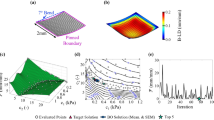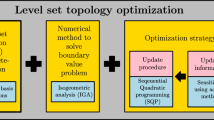Abstract
We present a computational efficient method for isotropic hyper elasticity based on functional analysis. By selecting a class of shape functions, we arrive at a computational scheme which yields very sparse tensors. This enables fast computations of the hyper elastic energy potential and its derivatives. We achieve efficiency and performance through the use of shape functions that are linear in their parameters and through rotation into the eigenspace of the right Cauchy–Green strain tensor. This makes near real time evaluation of hyper elasticity of complex meshes on CPU relatively easy to implement. The approach does not rely on a specific shape function or material model but offers a general framework for isotropic hyper elasticity. The method is aimed at interactive and accurate non-linear hyper elastic modeling for a wide range of industrial virtual design applications, which we exemplify by insertion of hearing aid domes into the ear canal. We validate the method for tetrahedral meshes with linear shape functions with an Ogden material model by comparing simulations to deformations of real material. We illustrate the use of other shape functions and models using uniform cubic B-splines in combination with Riemannian elasticity.
Similar content being viewed by others
References
Baerentzen, J.A., Aanaes, H.: Signed distance computation using the angle weighted pseudonormal. IEEE Trans. Vis. Comput. Graph. 11, 243–253 (2005)
Baraff, D., Witkin, A.: Large steps in cloth simulation. In: SIGGRAPH ’98: Proceedings of the 25th Annual Conference on Computer Graphics and Interactive Techniques, pp. 43–54. ACM, New York (1998)
Barbič, J., James, D.L.: Real-time subspace integration for St. Venant-Kirchhoff deformable models. ACM Trans. Graph. 24, 982–990 (2005)
Bargteil, A.W., Wojtan, C., Hodgins, J.K., Turk, G.: A finite element method for animating large viscoplastic flow. ACM Trans. Graph. 26 (2007)
Bergou, M., Wardetzky, M., Robinson, S., Audoly, B., Grinspun, E.: Discrete elastic rods. ACM Trans. Graph. 27(3), 1–12 (2008)
Bonet, J., Wood, R.D.: Nonlinear Continuum Mechanics for Finite Element Analysis. Cambridge University Press, Cambridge (2008)
Botsch, M., Pauly, M., Gross, M., Kobbelt, L.: Primo: coupled prisms for intuitive surface modeling. In: Proceedings of the 4th Eurographics Symposium on Geometry Processing, SGP ’06, pp. 11–20. Eurographics Association, Aire-la-Ville (2006)
Bridson, R., Fedkiw, R., Anderson, J.: Robust treatment of collisions, contact and friction for cloth animation. In: SIGGRAPH ’02: Proceedings of the 29th Annual Conference on Computer Graphics and Interactive Techniques, pp. 594–603. ACM, New York (2002)
Choi, M.G., Ko, H.S.: Modal warping: real-time simulation of large rotational deformation and manipulation. IEEE Trans. Vis. Comput. Graph. 11, 91–101 (2005)
Darkner, S., Vester-Christensen, M., Larsen, R., Paulsen, R.R., Nielsen, C.: Automated 3D rigid registration of open 2D manifolds. In: Proceedings from Statistical Atlases to Personalized Models Workshop, MICCAI 2006, pp. 19–22 (2006)
Debunne, G., Desbrun, M., Cani, M.P., Barr, A.H.: Dynamic real-time deformations using space & time adaptive sampling. In: Proceedings of the 28th Annual Conference on Computer Graphics and Interactive Techniques, SIGGRAPH ’01, pp. 31–36. ACM, New York (2001)
Galoppo, N., Otaduy, M., Tekin, S., Gross, M., Lin, M.: Soft articulated characters with fast contact handling. Comput. Graph. Forum 26(3), 243–253 (2007)
Galoppo, N., Otaduy, M.A., Moss, W., Sewall, J., Curtis, S., Lin, M.C.: Controlling deformable material with dynamic morph targets. In: Proceedings of the 2009 Symposium on Interactive 3D Graphics and Games, I3D ’09, pp. 39–47. ACM, New York (2009)
Georgii, J., Westermann, R.: Corotated finite elements made fast and stable. In: Proceedings of the 5th Workshop on Virtual Reality Interaction and Physical Simulation, pp. 11–19 (2008)
Grinspun, E.: A discrete model of thin shells. In: SIGGRAPH ’06: ACM SIGGRAPH 2006 Courses, pp. 14–19. ACM, New York (2006)
Irving, G., Teran, J., Fedkiw, R.: Invertible finite elements for robust simulation of large deformation. In: Proceedings of the 2004 ACM SIGGRAPH/Eurographics Symposium on Computer Animation, SCA ’04, pp. 131–140. Eurographics Association, Aire-la-Ville (2004)
Irving, G., Teran, J., Fedkiw, R.: Tetrahedral and hexahedral invertible finite elements. Graph. Models 68, 66–89 (2006)
Irving, G., Schroeder, C., Fedkiw, R.: Volume conserving finite element simulations of deformable models. ACM Trans. Graph. 26 (2007)
Mauch, S.P.: Efficient algorithms for solving static Hamilton-Jacobi equations. Ph.D. thesis, Pasadena, CA, USA (2003). AAI3093495
Müller, M., Gross, M.: Interactive virtual materials. In: Proceedings of Graphics Interface 2004, GI’04, pp. 239–246. Canadian Human-Computer Communications Society, School of Computer Science, University of Waterloo, Waterloo (2004)
Müller, M., Dorsey, J., McMillan, L., Jagnow, R., Cutler, B.: Stable real-time deformations. In: Symposium on Computer Animation: Proceedings of the 2002 ACM SIGGRAPH/Eurographics Symposium on Computer Animation, vol. 21(22), pp. 49–54 (2002)
Müller, M., Keiser, R., Nealen, A., Pauly, M., Gross, M., Alexa, M.: Point based animation of elastic, plastic and melting objects. In: Proceedings of the 2004 ACM SIGGRAPH/Eurographics Symposium on Computer Animation, SCA ’04, pp. 141–151. Eurographics Association, Aire-la-Ville (2004)
Müller, M., Heidelberger, B., Teschner, M., Gross, M.: Meshless deformations based on shape matching. ACM Trans. Graph. 24, 471–478 (2005)
Müller, M., Heidelberger, B., Hennix, M., Ratcliff, J.: Position based dynamics. J. Vis. Commun. Image Represent. 18, 109–118 (2007)
O’Brien, J.F., Hodgins, J.K.: Graphical modeling and animation of brittle fracture. In: Proceedings of the 26th Annual Conference on Computer Graphics and Interactive Techniques, SIGGRAPH ’99, pp. 137–146. ACM/Addison-Wesley, New York (1999)
Ogden, R.: Large deformation isotropic elasticity-on the correlation of theory and experiment for incompressible rubberlike solids. Proc. R. Soc. Lond. Ser. A, Math. Phys. Sci. 326(1567), 565–584 (1972) (1934–1990)
Pennec, X., Stefanescu, R., Arsigny, V., Fillard, P., Ayache, N.: Riemannian elasticity: a statistical regularization framework for non-linear registration. In: MICCAI, vol. 3750, p. 943 (2005)
Schmedding, R., Teschner, M.: Inversion handling for stable deformable modeling. Vis. Comput. 24, 625–633 (2008)
Selle, A., Lentine, M., Fedkiw, R.: A mass spring model for hair simulation. ACM Trans. Graph. 27(3), 1–11 (2008)
Si, H.: Tetgen: a quality tetrahedral mesh generator and three-dimensional Delaunay triangulator. Opensource Proj. (2011)
Sigg, C., Peikert, R., Gross, M.: Signed distance transform using graphics hardware. In: Proceedings of the 14th IEEE Visualization 2003, VIS ’03, p. 12. IEEE Computer Society, Washington (2003)
Teran, J., Blemker, S., Hing, V.N.T., Fedkiw, R.: Finite volume methods for the simulation of skeletal muscle. In: Proceedings of the 2003 ACM SIGGRAPH/Eurographics Symposium on Computer Animation, SCA ’03, pp. 68–74. Eurographics Association, Aire-la-Ville (2003)
Teran, J., Sifakis, E., Irving, G., Fedkiw, R.: Robust quasistatic finite elements and flesh simulation. In: Proceedings of the 2005 ACM SIGGRAPH/Eurographics Symposium on Computer Animation, SCA ’05, pp. 181–190. ACM, New York (2005)
Terzopoulos, D., Platt, J., Barr, A., Fleischer, K.: Elastically deformable models. SIGGRAPH Comput. Graph. 21, 205–214 (1987)
Teschner, M., Heidelberger, B., Muller, M., Gross, M.: A versatile and robust model for geometrically complex deformable solids. In: CGI ’04: Proceedings of the Computer Graphics International, pp. 312–319. IEEE Computer Society, Washington (2004)
Wicke, M., Ritchie, D., Klingner, B.M., Burke, S., Shewchuk, J.R., O’Brien, J.F.: Dynamic local remeshing for elastoplastic simulation. ACM Trans. Graph. 29, 49:1–49:11 (2010)
Wright, J.N.S.J.: Numerical Optimization, 2nd edn. Springer, Berlin (2006)
Zhu, Y., Sifakis, E., Teran, J., Brandt, A.: An efficient multigrid method for the simulation of high-resolution elastic solids. ACM Trans. Graph. 29, 16:1–16:18 (2010)
Author information
Authors and Affiliations
Corresponding author
Rights and permissions
About this article
Cite this article
Darkner, S., Erleben, K. A hyper elasticity method for interactive virtual design of hearing aids. Vis Comput 27, 645–653 (2011). https://doi.org/10.1007/s00371-011-0574-y
Published:
Issue Date:
DOI: https://doi.org/10.1007/s00371-011-0574-y




